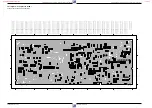
2 - 6
GRUNDIG Service-Technik
Beschreibungen / Descriptions
Stufe besteht aus R3037, C2019 und C2020. Die Wiedergabeamplitude
ist mit dem Einsteller R3039 (Y-PB LEVEL) über IC7051-(2) einstell-
bar. Danach gelangt das BAS-Signal über ein Phasenkorrekturglied
(T7006 / R3033 / C2095 / L5025), eine Verstärkerstufe (T7007) und
C2012 zum IC7051-(4). Das Signal wird im IC7051 vor dem A/W-
Schalter und nach dem folgenden 3,5MHz-Tiefpaßfilter geklemmt
(CLAMP).
Danach teilt sich der Signalweg. Zum einen durchläuft das Luminanz-
Signal einen Dropout-Schalter und verläßt nach einem A/W-Schalter
den IC7051 am Pin 12. In der folgenden Verzögerungsschaltung
(IC7504 / T7032 / T7031) wird es um eine Zeile verzögert und über
IC7051-(10) und die folgende Verstärkerstufe (VCA) dem Dropout-
Schalter zugeführt. Treten dropoutbehaftete Signale auf, werden
diese durch Umschalten des Dropout-Schalters durch das einwandfreie,
verzögerte Signal ersetzt. Zum anderen wird das unverzögerte und
das verzögerte BAS-Signal in einem Differenzverstärker subtrahiert
und die dabei entstehende, niederfrequente Rauschspannung über
ein Bewertungsfilter mit dem unverzögerten Y-Signal gegenphasig
addiert. Das rauschverminderte Y-Signal durchläuft die nichtlineare
Deemphasis (NL DE EMPHASIS), die Rauschunterdrückung (WIDE
NOI CAN) für hochfrequente Rauschspannungen und eine Stufe zur
Höhenanhebung (PICTURE CONTROL). In der nachfolgenden "Y-C-
MIX-Stufe" wird das Y-Signal mit dem intern zugeführten Chromasig-
nal addiert. Das zurückgewonnene FBAS-Signal durchläuft einen A/
W-Schalter, die V-Impulseintastung (INSERT W/D CLIP), einen Vi-
deo-Verstärker (VIDEO AMP) und verläßt an Pin 34 den IC7051.
Danach führt man das FBAS-Signal (VSB) zur Verstärkerstufe T7502.
Von dort gelangt es zum einen direkt zur EURO-AV-Buchse und zum
anderen über den RF-Equalizer F1501 sowie die Verstärkerstufe
T7506 zum Modulator.
2.3.2 Chassisplatte – Chroma
Funktionsübersicht
Bei Aufnahme wird das 4,43MHz-F-Signal mit Hilfe einer Mischfre-
quenz (5,06MHz) auf 627kHz umgesetzt.
Bei Wiedergabe wird aus dem 627kHz-F-Signal mit Hilfe der Mischfre-
quenz (5,06MHz) das ursprüngliche 4,43MHz-F-Signal wiedererstellt.
Es wird verstärkt, zum Luminanz-Signal addiert und dem Modulator
bzw. der EURO-AV-Buchse zugeführt.
Aufnahme
Der Signalweg ist bei Aufnahme für PAL und MESECAM (Secam Ost)
gleich. Das FBAS-Signal (VBS) vom Eingangswahlschalter wird über
Pin 37 dem IC7051 zugeführt. In diesem IC durchläuft es die Video-
AGC-Stufe, einen -6dB-Abschwächer und einen integrierten Bandpaß
(4,43MHz). Hier wird das Chroma-Signal vom FBAS-Signal heraus-
gefiltert. Anschließend gelangt das Chroma-Signal über einen A/W-
Schalter, einen Regelverstärker (ACC AMP) und eine Burst-Empha-
sisstufe (unwirksam) zum Hauptmischer (MAIN CONV). Im Hauptmi-
scher werden das Chromasignal (4,43MHz) und die anstehende
Hilfsträgerfrequenz (5,06MHz) gemischt. Das umgesetzte Chroma-
signal (627kHz) wird im internen Tiefpaß von unerwünschten Misch-
produkten befreit. Nach dem folgenden Farbkiller und dem A/W-
Schalter gelangt es zum Pin 15 des IC7051. Danach führt man es über
den Einsteller für den Chroma-Aufsprechstrom, R3096 (CHROMI-
NANCE WRITING CURRENT), zum Knotenpunkt R3096 / R3100. An
diesem wird es mit dem Y-Signal addiert. Das Summenprodukt (FMRV)
führt man über die Verstärkerstufe T7029 / T7030 und Steckerkontakt
F5-2 dem Kopfverstärker zu.
Wiedergabe
Über den Steckerkontakt F5-9 erreicht das Signal vom Band (FMPV)
den Chromaschaltungsteil. Im Bandpaß (R3089…C2080) wird das
627kHz-Chromasignal herausgefiltert. Die nachfolgende Transistor-
stufe T7026 / T7025 verstärkt das Signal und leitet es weiter zum
IC7051-(15). Von hier läuft es über zwei A/W-Schalter, einen geregel-
ten Verstärker (ACC AMP), eine Burst-Emphasis-Stufe (unwirksam),
zum Hauptmischer (MAIN CONV). Hier wird es mit der Hilfsträger-
frequenz (5,06MHz) gemischt. Das zurückgewonnene Chromasignal
(4,43MHz) gelangt danach über einen A/W-Schalter zum integrierten
4,43MHz-Bandpaß. Nach einem weiteren A/W-Schalter kommt es
zum einen bei SECAM direkt zum PAL-/SECAM-Schalter. Zum ande-
ren verläßt es bei PAL nach dem Kammfiltertreiber den IC7051 an Pin
25 und gelangt über den Verstärker T7016 zum Kammfilter (CF873)
sowie über IC7051-(27) zum PAL-/SECAM-Schalter.
Die Funktion eines Kammfilters besteht darin, in einem Schaltungs-
zweig, CF873-(4), das jeweilige Signal bei PAL um 2 Zeilen zu
is possible with the control R3039 (Y-PB LEVEL) via IC7051-(2).
Afterwards, the CVS signal is passed on via a phase compensation
stage (T7006 / R3033 / C2095 / L5025), an amplifier stage (T7007)
and C2012 to IC7051-(4). In IC7051, the signal is clamped (CLAMP)
before the A/W-switch and after the 3.5MHz-lowpass filter which
follows.
Afterwards, the signal path divides. In one path, the luminance signal
is fed through a dropout switch and, after an A/W-switch, leaves the
IC7051 on Pin 12. In the following delay circuit (IC7504 / T7032 /
T7031) the signal is delayed by one line and is then taken via
IC7051-(10) and the following amplifier stage (VCA) to the dropout
switch. If dropouts occur in the signal, the dropout switch changes over
replacing the faulty signal by the faultless delayed signal. In the other
path, the non-delayed and delayed CVS signals are subtracted in a
difference amplifier. The resulting low-frequency noise voltage is
added at opposite phase to the non-delayed Y-signal via a weighting
network. The noise-reduced Y-signal passes through the non-linear
deemphasis (NL DE EMPHASIS), the noise reduction stage (WIDE
NOI CAN) for high-frequency noise voltages and a high-frequency
preemphasis (PICTURE CONTROL). In the following "Y-C-MIX" stage
the Y-signal is added to the internally fed in chroma signal. The
regenerated CCVS signal is passed through an A/W-switch, the V-
pulse insertion stage (INSERT W/D CLIP), a video amplifier (VIDEO
AMP) and is fed out from pin 34 of the IC7051. Subsequently, the
CCVS signal (VSB) is taken to the amplifier stage T7502 where it is
directly passed on to the EURO-AV-socket and on another path it is fed
via an RF equalizer F1501 and the amplifier stage T7506 to the
modulator.
2.3.2 Family Board – Chroma
Function Overview
On record the 4.43MHz chroma signal is converted to 627kHz with the
aid of a mixing frequency of 5.06MHz.
On playback the 627kHz chroma signal is reconverted into the original
4.43MHz chroma signal with the aid of the mixing frequency (5.06MHz).
The signal is amplified, added to the luminance signal and passed on
to the modulator or the EURO-AV-socket.
Record
On record the signal path is the same for PAL and MESECAM (Secam
East). The CCVS signal (VBS) is supplied from the input selector
switch to the IC7051via pin 37. In this IC, the signal passes through the
Video-AGC-circuit, a -6dB-attenuator and an integrated bandpass
(4.43MHz). Here, the chroma signal is separated from the CCVS
signal. The chroma signal is then taken via an A/W-switch, a gain
controlled amplifier (ACC AMP) and a burst emphasis stage (not
active) to the main converter (MAIN CONV). In the main converter, the
chroma signal (4.43MHz) is mixed with the subcarrier frequency
(5.06MHz). In an internal lowpass filter unwanted mixing products are
eliminated from the converted chroma signal (627kHz). Having passed
the colour killer which follows and the A/W-switch the signal arrives at
pin 15 of IC7051. It is then fed through an adjustment control for the
chroma recording current, R3096 (CHROMINANCE WRITING CUR-
RENT) to the junction R3096/R3100 where the signal is added to the
Y-signal. The sum signal (FMRV) is taken via the amplifier stage
T7029 / T7030 and plug contact F5-2 to the head amplifier.
Playback
Via plug contact F5-9 the signal from the tape (FMPV) arrives at the
chroma circuit stage. In the bandpass (R3089…C2080), the 627kHz
chroma signal is filtered out to be amplified in the following transistor
stage T7026 / T7025 and fed to IC7051-(15). The signal then passes
two A/W switches, a gain controlled amplifier (ACC AMP), a burst
emphasis stage (not active) and arrives at the main converter (MAIN
CONV) where it is mixed with the subcarrier frequency (5.06MHz). The
reconverted chroma signal (4.43MHz) is fed through an A/W-switch to
the integrated 4.43MHz bandpass. Having passed another A/W-
switch, the signal is applied directly to the PAL/SECAM switch on
SECAM mode. On PAL mode, the signal is subjected to the comb
driver and is fed out from IC7051 pin 25 to be supplied via an amplifier
T7016 to the comb filter (CF873) and via IC7051-(27) to the PAL/
SECAM switch.
The function of a comb filter is to delay the signal in one branch circuit
CF873-(4) by two lines periods for the PAL system and to add it to the
www.freeservicemanuals.info
It`s Free
















































